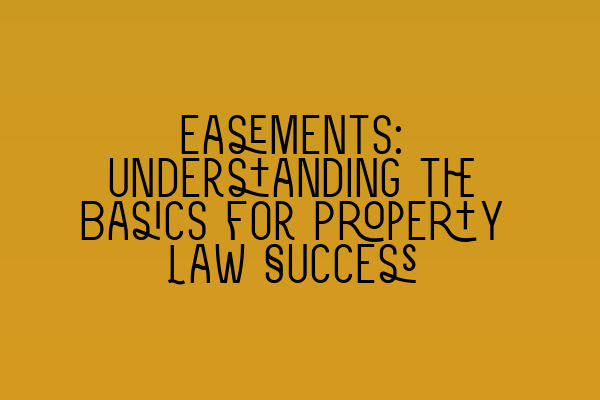Easements: Understanding the Basics for Property Law Success
Welcome to SQE Property Law & Land Law. As experts in property law, our goal is to provide you with comprehensive knowledge and understanding of various legal concepts. In this blog post, we will dive deep into the world of easements and help you grasp the basics to ensure success in your property law endeavors.
What are Easements?
Let’s begin by defining easements. An easement is a legal right that allows a person (known as the dominant owner) to use the land of another (known as the servient owner) for a specific purpose. Easements can grant various rights, such as the right to access a neighboring property, the right to pass through a particular area, or the right to use utilities like water, gas, or electricity.
Understanding easements is essential for property law practitioners, as they often arise in real estate transactions, boundary disputes, and land development projects. Having a solid grasp of easement laws can make a significant difference in the outcomes of legal cases and negotiations.
Types of Easements
Now that we know what easements are let’s explore the different types:
1. Appurtenant Easement
Appurtenant easements are attached to the ownership of a particular property and benefit its owner. These easements are commonly seen in situations where neighboring properties share a common driveway, pathway, or access route. The dominant owner has the right to use the easement, while the servient owner must allow such use. It’s important to note that if the dominant property is sold, the easement typically transfers to the new owner.
2. Easement in Gross
In contrast to appurtenant easements, easements in gross do not benefit a particular property but instead benefit a specific person or entity. These easements often arise in utility or infrastructure-related cases, where utility companies or government bodies need access to privately owned land to install or maintain their services. Easements in gross are generally not transferable unless explicitly stated.
3. Prescriptive Easement
Prescriptive easements are acquired through continuous, open, and hostile use of another person’s land without permission. If a person continuously and openly uses another’s land for a specific purpose without objection from the landowner for a certain statutory period, they may gain a legal right to continue such use. This is similar to adverse possession, but instead of claiming ownership, the individual claims the right to use the land.
4. Easements by Necessity
Easements by necessity are created when a landowner sells a portion of their land that does not have access to a public road, and the new owner requires access to their property. In such cases, an easement is implied to ensure reasonable access to the landlocked property. Easements by necessity are limited to what is reasonably required to access the property and cease to exist if access is no longer necessary.
Importance of Easement Agreements
Having a clear and legally binding easement agreement is crucial to avoid disputes and ensure the smooth functioning of property rights. When drafting or reviewing easement agreements, it’s essential to consider elements such as the scope of the easement, any limitations or restrictions, maintenance responsibilities, and termination conditions. By clearly defining these terms, all parties involved can facilitate a harmonious coexistence and prevent future conflicts.
Why Choose SQE Property Law & Land Law?
At SQE Property Law & Land Law, we are committed to providing high-quality education and guidance to aspiring property law professionals. Our extensive range of SQE preparation courses, including SQE 1 and SQE 2, will equip you with the necessary knowledge and skills to excel in your legal career.
For those preparing for the upcoming SQE exams, we offer practice exam questions and mocks that simulate the real exam environment. Practice makes perfect, and by regularly testing your knowledge, you can identify areas that require further study and increase your chances of success. Check out our SQE 1 Practice Exam Questions and SQE 1 Practice Mocks FLK1 FLK2 to get started.
To maximize your chances of success in the SQE exams, enroll in our comprehensive SQE 2 Preparation Courses and SQE 1 Preparation Courses. Our experienced tutors will guide you through the intricacies of property law and land law, ensuring you are well-prepared for the exam.
Stay updated with the latest news and information about SQE exams by regularly checking the SRA SQE Exam Dates. Proper planning and preparation can significantly enhance your chances of success.
Conclusion
Easements are a fundamental aspect of property law, and understanding their basics is essential for success in this field. Whether you are a solicitor, a property owner, or a law student, having a thorough understanding of easements can help you navigate legal complexities, resolve disputes, and protect your property rights.
At SQE Property Law & Land Law, we are here to support you on your journey towards property law success. Take advantage of our preparation courses and resources to enhance your knowledge and skills. Together, let’s build a strong foundation in property law and pave the way for a successful legal career.
